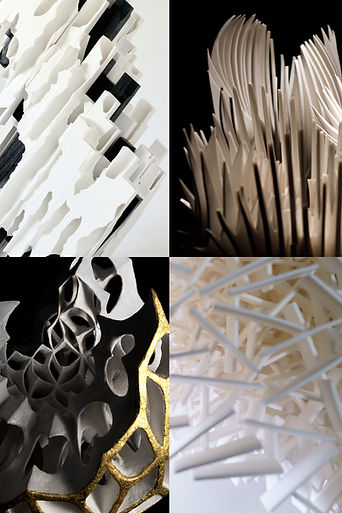Kouzo Takeuchi, Kazuki Takemura, Masafumi Takana, Yuki Nara
"FRACTAL SYNERGY"
17th April (Sat) – 26th June (Sat), 2021
Hours:13:00~19:00, closed Sundays
YOD Gallery is delighted to present "Fractal Synergy," a group exhibition of Kouzo Takeuchi, Kazuki Takemura, Masafumi Tanaka, and Yuki Nara.
In this exhibition, four contemporary ceramic artists who have been focusing on geometric compositions gather to create a space where their works resonate with each other. “Fractal” is a geometric term that refers to an object similar to itself on all scales, the “synergy” of which has become the title of this exhibition. Here, each of the artists has their basic form and composition and explores how they could be developed to the maximum. By lining up all-in-white works of these artists, the exhibition aims to bring about further dialogues and discoveries.
Ceramics are often associated with the softness of form and the power of flame, yet this exhibition aims to feature ceramics that overturn this image. At first sight, these works might seem to have been created by a 3D printed due to their geometric compositions and the application of computer technologies during the production. We would like to present to you how the four artists explore contemporary expressions in the classical art form and hope you will enjoy this exhibition.
‘Fractal Synergy: Beyond the Boundary’
“Fractal” is a geometric concept with self-similarity that refers to an object similar to itself on all scales. The synergy of which has become the title of this exhibition, it suggests mutual characters between the four artists' ceramic works on the continuity, accumulation, and construction of ceramics. We would like to discuss contemporaneity and artists' self-expression throughout these works.
The time in which artists live always has a significant influence on them. No matter how they recall the past, record the present, or look into the future, their viewpoints are always based on contemporary times, or more specifically, the present. Looking back at the ages Takeuchi, the eldest of the four, has lived in, we can realize how dizzying changes have undergone in terms of science and technology as well as people's way of thinking, and how an age that embraces diversity and different opinions has arrived. Similarly, we could discover how the four artists have been working beyond the existing qualities of ceramic arts to create their unique art language. The realm of ceramic art has extended considerably to painting, sculpture, craft, and design, yet the expansion is still ongoing. What remains unchanged is the core, the clay, and the senses it arouses, such as tactile sense and olfaction.
Takeuchi finds strength and beauty in the imperfect ephemerality of decayed forms and ruins. By breaking assembled works, he plays with the time axis of creation and destruction while questions the stereotypical notion in ceramic art in which being 'broken' has a negative image.
Tanaka's works are composed with the assembly of small pieces and illustrate the power of assemblage. In Tanaka's works constructed by white rectangle pieces, a tricky change of the way of seeing is always undergone when fine porcelain pieces are gathered and presented as an accumulated piece of art.
Takemura glues hand-twisted pieces together to construct a geometric form that came to terms with all kinds of restrictions. While one may get the impression of an inorganic form from afar, when they get closer, they may find a sense of life and vitality brought out by the dynamic fluctuations of lines and the meticulous structure.
Nara brings in an architectural sense in his art by applying 3D CAD techniques and combines its unique quality naturally with ceramics. As a cross-genre, borderless and contemporary approach to contemporary ceramic art, Nara's works encompass the timeless Japanese aesthetic and values that can be traced back to Jomon earthenware.
Despite their different concepts, the four artists share how they work beyond the existing techniques and expressions of clay and challenge the tradition. Therefore, they seem to have broken a path from stereotypes to a world that embraces and reflects the diversity of the modern age in a vivid way.
(Murakami Fumi, curator of The Museum of Ceramic Art, Hyogo)

